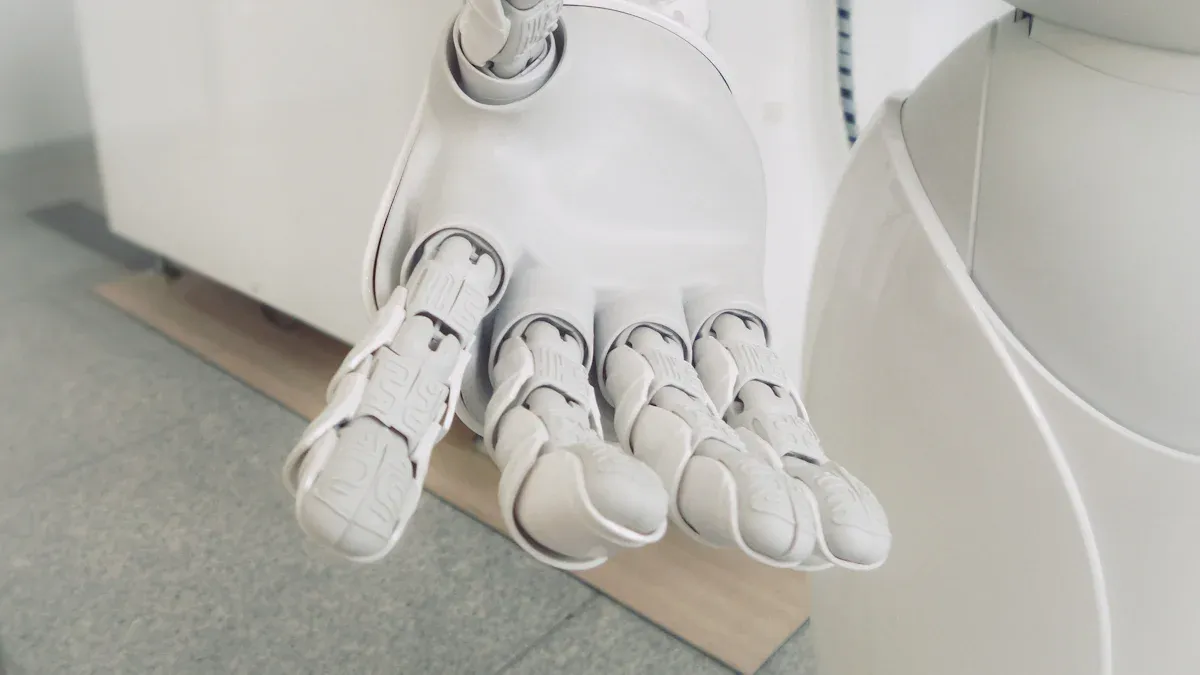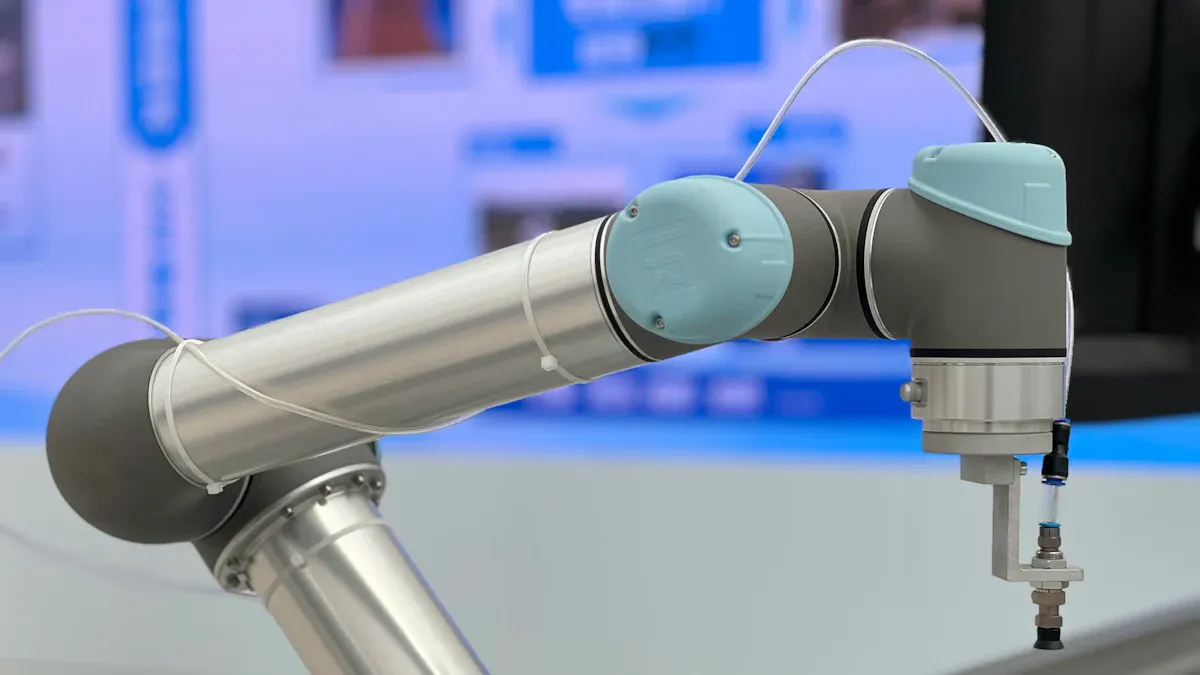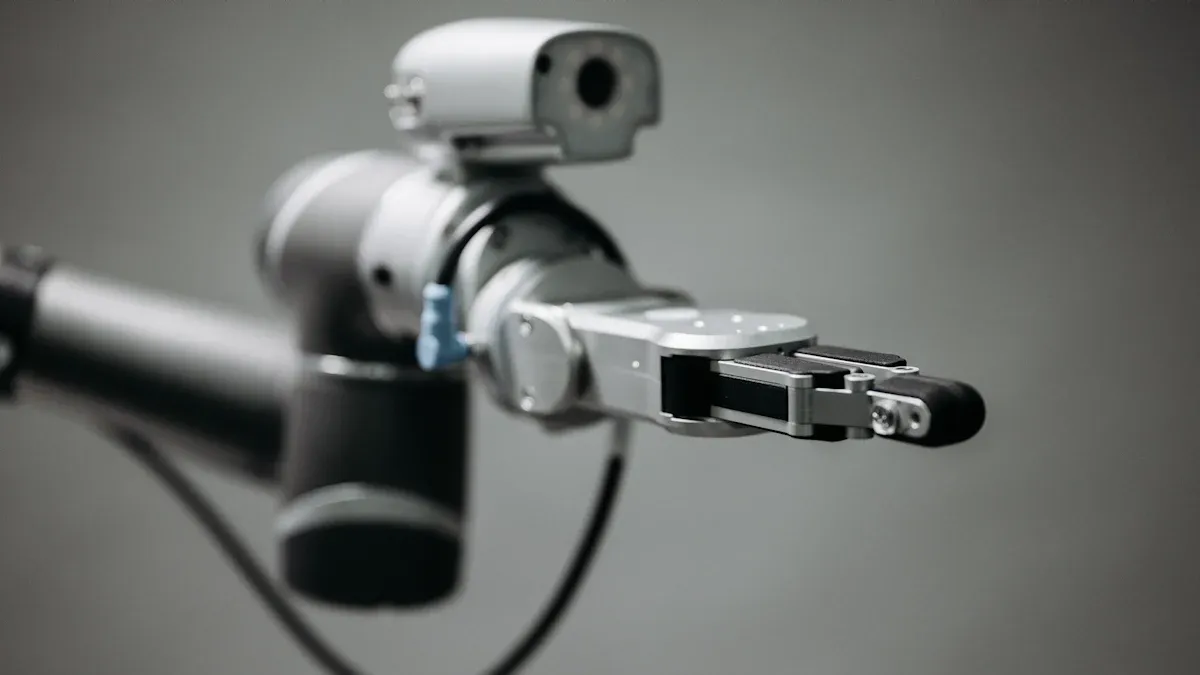May.
07, 2025
Contents
How Surface Finishing Impacts Robot Joint Performance
Understanding Surface Finishing in Robotics
Effects of Surface Finishing on Robot Joint Performance
Techniques for Achieving Optimal Surface Finishing
Advantages of Proper Surface Finishing in Robotics
Challenges in Surface Finishing for Robot Joints

Surface finishing is very important for how robot joints work. It affects how well joints avoid damage, reduce rubbing, and stay accurate. For example, smoother surfaces cause less rubbing, with friction levels between 0.0922 and 0.1259 based on the finish. Even small changes in friction can change how smoothly a robot moves and how long its parts last. Better surface finishing helps robots move easier, wear out slower, and work more accurately.
Surface finishing means changing a material's surface to make it smoother, shinier, or look a certain way. This process is important in making things last longer and work better. For robot joints, it helps them move smoothly, wear out less, and work more efficiently.
There are different ways to measure and create surface finishes. These include:
| Method Type | Description | Usage |
|---|---|---|
| Contact Methods | Tools touch the surface to check roughness. | Great for precise work but not for soft materials. |
| Non-contact Methods | Use lasers or light to measure roughness without touching. | Good for fragile surfaces; results depend on how shiny the material is. |
| Comparison Methods | Match the surface to a standard example. | Fast and cheap but less exact; best for simple checks. |
| In-process Methods | Check roughness while making the product. | Useful for mass production; less accurate than after-production checks. |
| Profiling Techniques | Make a 3D map of the surface. | Best for research; takes time and needs special tools. |
| Area Techniques | Measure roughness over a big area. | Good for uneven surfaces; not great for tiny details. |
| Microscopy Techniques | Zoom in to see the surface up close. | Helpful in research; needs advanced equipment. |
Each method has pros and cons, but all aim to meet specific surface needs.
Why is surface finishing so important for robot joints? It’s because it directly affects how robots work. A smooth surface lowers friction, helping joints move easily. It also reduces damage, making parts last longer.
For instance, changing how a robot’s joint moves during polishing can improve the surface finish. This adjustment makes the robot work better and more smoothly.
Surface finishing also helps with coating stickiness, heat control, and light reflection. These factors make robots stronger and more precise, which is why surface finishing is a key part of building robots.
Surface finishing changes many important features for robots, such as:
| Key Properties Influenced by Surface Finishing | Description |
|---|---|
| Automation and Flexibility | Makes robots better at handling different tasks. |
| Reduction of Programming Effort | Easier to teach robots how to move, saving time. |
| Capability to Finish Moving Surfaces | Robots can polish surfaces that are moving. |
| Use of Novel Slip Sensor | Sensors help measure motion for better polishing. |
| Integration with Force Control | Combining sensors and force control improves polishing tasks. |
By improving these features, surface finishing helps robots do hard jobs more accurately and efficiently.

Surface finishing helps robot joints stay strong and last longer. Smoother surfaces make joints resist damage from constant movement. Techniques like drag finishing and electropolishing create smooth surfaces. These methods lower friction and protect joints from wearing out.
Here’s how different techniques improve joint durability:
| Technique | Benefits |
|---|---|
| Drag Finishing | Makes joints stronger and reduces friction for longer use. |
| Automated Robotic Polishing | Ensures smooth, durable joints with precise and consistent results. |
| Electropolishing | Creates very smooth surfaces that resist wear and rust. |
Using these methods keeps robot joints working well, even in tough conditions.
Friction can make robots move slower and strain their joints. Surface finishing reduces friction, so robots move more easily. Polished joints slide smoothly against other parts, improving motion. This also stops overheating caused by friction.
Think of a robot arm picking up fragile items. A rough joint might stick or jerk, making it hard to work. But a polished joint moves smoothly, making tasks easier and more accurate. Automated robotic polishing is great for achieving this smoothness.
Robots need to be precise, especially for detailed tasks. Surface finishing removes rough spots, helping joints move exactly as needed. This is very important in fields like healthcare or electronics, where small mistakes matter.
For example, electropolishing makes surfaces super smooth for accurate movements. This ensures robots can repeat tasks without losing precision. By focusing on surface finishing, robots can work with top-level accuracy.
Energy efficiency is very important for robots. Smooth-moving joints use less energy. Surface finishing helps by lowering friction between parts. Polished joints need less force to move, saving energy. This not only saves power but also makes robot parts last longer.
Maintenance is also improved with surface finishing. Rough surfaces wear out quickly and need fixing often. Smoother surfaces reduce wear and tear, needing fewer repairs. For example, electropolishing removes tiny flaws that cause damage. This keeps robot joints in good shape for a longer time.
Less maintenance saves both time and money. Robots with smooth joints break down less often. This means they work more and stop less. Imagine robots in a factory working without delays. Good surface finishing makes this possible by improving strength and reliability.
Smoother surfaces also help with heat control. Friction creates heat, which can harm parts. By reducing friction, surface finishing keeps joints cooler. This stops overheating and keeps robots working well.
In short, surface finishing improves energy use and lowers maintenance needs. It helps robots work better and saves resources. Whether for factories or hospitals, good surface finishing is key for success.

Grinding and polishing are key for smooth robot joints. These methods use rough tools to fix flaws and smooth surfaces. Robots with smart controls can handle different shapes and textures. For example, the SC3DP project shows how a spinning steel disc on a 5-axis robot can polish tricky designs. This method saves time by finishing surfaces while materials are still soft.
Heavy-duty grinding and polishing robots are stable and reduce shaking. Their six-axis movement allows fast work without losing accuracy. These features make them great for improving robot joint performance.
Chemical and electrochemical methods offer advanced surface finishing. Processes like electroplating and electropolishing make surfaces stronger and smoother. Electroplating adds a thin metal layer, making parts harder and less likely to wear out. It also improves electrical flow, helping sensors and robot parts work better.
Electropolishing removes material to create very smooth surfaces that resist rust. This works well for metals like stainless steel and aluminum. These methods help robots last longer and work more reliably.
Laser and plasma treatments are high-tech ways to finish surfaces. Lasers change surfaces without touching them, which is good for delicate materials. A specific laser wavelength cleans and smooths metals effectively. Patterns like lines or grids improve sticking and remove dirt.
Plasma treatments also give even finishes and make robot joints stronger. Line patterns create smooth surfaces quickly, while grid patterns balance stickiness and speed. These advanced tools ensure precise results, even on tough surfaces.
Picking the best surface finishing method is very important. Each method has its own benefits, but not all work for every job. To decide, you need to think about a few key things.
The material in robot joints affects which method works best. For example:
Metals like stainless steel use electropolishing to stop rust.
Delicate materials need laser treatments to avoid damage.
Tip: Test a small piece of your material first.
Think about what the robot will do. Medical robots need smooth surfaces from plasma treatments. Industrial robots can use mechanical polishing for tough jobs.
Some methods, like laser finishing, work great but cost more. If money is tight, grinding and polishing are cheaper options.
| Technique | Cost | Best For |
|---|---|---|
| Grinding/Polishing | Low | Everyday tasks |
| Electropolishing | Moderate | Rust prevention and strength |
| Laser Treatments | High | Precision and fragile materials |
Chemical methods can make waste that needs safe disposal. If you care about the planet, choose eco-friendly options like plasma treatments.
By thinking about these points, you can pick the right method for your robot. This helps it work better, last longer, and save money.
Remember: The right method improves how joints work and keeps robots strong.
Good surface finishing helps robot joints last longer. Smooth surfaces lower friction, reducing wear and tear. This keeps joints working well, even with constant use. For example, finishes like immersion tin and ENEPIG improve solder joints' strength and heat resistance. These finishes create stable intermetallic compounds (IMCs) that boost reliability.
| Surface Finish | Main Benefits | Intermetallic Compounds (IMCs) | Effect on Reliability |
|---|---|---|---|
| Immersion Tin | Strong solder joint connections | Cu6Sn5, Cu3Sn | Improves mechanical and thermal strength |
| ENEPIG | Works with many assembly methods | (Ni,Pd)Sn | Provides excellent reliability with stable IMCs |
Choosing the right surface finish ensures robots work well, even in tough conditions.
Surface finishing makes robots work faster and smoother. Polished surfaces reduce friction, helping joints move easily. This saves energy and increases speed. For example, GrayMatter Robotics showed sanding robots cut waste by 50% and sped up production. Similarly, Midwest Engineered Systems used AI robots to reduce rework and material waste.
Benefits of Better Efficiency:
Faster work due to smoother movements.
Less energy use, saving money.
Higher accuracy for detailed tasks.
Investing in surface finishing helps robots work better and lowers costs.
Robots with smooth surfaces need less fixing. Polished joints resist damage and rust, lasting longer. Special coatings and treatments make materials stronger and more durable. For instance, electropolishing removes tiny flaws that could cause damage. This keeps joints in great shape for a long time.
Surface finishing saves money by cutting maintenance costs. Companies using advanced techniques spend less on repairs and replacements. Robots last longer, break down less, and stay ready to work. This reduces downtime and boosts productivity.
Tip: Spending more on surface finishing now can save money later by reducing repairs.
By focusing on surface finishing, robots can work better, cost less to maintain, and avoid interruptions.
Robots often work in places that test their strength and efficiency. These include extreme heat, rough materials, and heavy tasks. Surface finishing helps robots stay strong and work well in these tough spots. It makes robot joints last longer, resist damage, and stay accurate.
Surface finishing is useful in many industries. For example:
| Application | How Surface Finishing Helps |
|---|---|
| Car Parts | Protects against wear, heat, and damage from road debris. |
| Pickleball Paddles | Improves ball control and meets rules for better player performance. |
In cars, surface finishing helps parts handle daily wear, like heat and debris. In sports gear, like pickleball paddles, it improves control and accuracy, boosting performance.
Stronger Against Harsh Conditions
Surface finishing adds a shield to protect joints from rust, scratches, and heat. This keeps robots safe from damage and working well.
Better Accuracy for Important Jobs
Smooth surfaces lower friction, helping joints move precisely. This is key in fields like healthcare, where robots do delicate tasks.
Longer-Lasting Parts
Harsh conditions can wear out robot parts quickly. Surface finishing spreads out stress and lowers wear, making parts last longer.
Saves Energy
Smooth joints need less energy to move. This saves power and stops overheating, which is common in hard jobs.
By using surface finishing, robots can handle tough jobs better. Whether in factories, hospitals, or outdoors, this process makes robots stronger and more reliable.
Tip: Spending on good surface finishing now can save money later by cutting repair costs and improving robot performance.
Advanced surface finishing methods can be very expensive. For example, robotic sanding systems need a big investment. But these systems have long-term benefits. They cut labor costs and improve productivity. They also make finished parts better in quality. Over time, the savings make up for the high cost. Many businesses find robotic sandblasting worth the money. While the upfront cost is high, it saves money later. It also boosts efficiency, making it a smart choice.
However, smaller companies may struggle with these costs. They might avoid these methods because of the high price. This shows the need for cheaper options. These options should balance good performance with lower costs.
The material in robot joints affects the finishing method you can use. Some metals, like stainless steel, work well with electropolishing. Others may not respond as well. Lightweight materials need gentler methods, like lasers. Matching the method to the material is very important.
Complex designs also make finishing harder. Tight spaces or odd shapes can be tricky to finish evenly. Methods like grinding may not reach every part. This can cause uneven surfaces, which hurt performance. Careful planning is needed to handle these challenges.
Robot joints with tricky movements need special care. Smooth finishes on these joints are hard to achieve. Medical and aerospace robots need perfect surfaces. Even small flaws can cause problems.
Adding sensors and force controls can help with finishing. But these tools are hard to set up and use. They need to be adjusted carefully for good results. If done wrong, the finish won’t meet standards. Solving these problems takes skill and new ideas. This makes it a tough job for manufacturers.
Making robot joints work well without spending too much is important. Here are simple ways to balance performance and cost:
Choose the Right Material:
Materials react differently to finishing methods. Stainless steel works well with electropolishing. Softer materials may need laser treatments. Picking the right material saves money and boosts performance.
Select Appropriate Techniques:
Not all methods fit every job. Grinding and polishing are cheaper for basic tasks. Laser treatments are better for precise work. Match the method to your needs for the best results.
Think About Long-Term Benefits:
Spending more on good finishing now can save later. It lowers repair costs and makes joints last longer. The upfront cost pays off over time.
Tip: Quality finishing reduces future expenses for fixing and replacing parts.
Improve Production Processes:
Using automated systems cuts labor costs and improves quality. This makes production faster and cheaper overall.
Consider Environmental Impact:
Some methods create waste that needs careful disposal. Eco-friendly options help the planet and lower waste costs.
By following these tips, you can make robot joints work well without overspending. The goal is to get great results while staying within budget.
Surface finishing is key to making robot joints work better. It helps parts last longer, reduces rubbing, and allows smooth movements. This makes robots stronger and more dependable. Smoother surfaces mean less fixing and save energy. High-tech methods like laser treatments and electropolishing help joints last even longer.
To keep up with future needs, new surface finishing ideas are important. Robotic sanding and finishing tools already make work safer and more consistent in industries like cars and planes. Future studies should focus on adding advanced tools to robots. This will help meet changing industry needs. By improving these methods, robots can work harder and stay useful for a long time.
Surface finishing makes robot joints work better. It lowers friction, makes them last longer, and improves accuracy. These changes help robots move easily, stay strong, and work well in different tasks.
Smooth surfaces wear out slower. This means fewer repairs or part changes are needed. Spending on good surface finishing now can save money later by keeping robot joints in good shape.
Laser treatments are great for fragile materials. They finish surfaces without touching them, avoiding damage. This method keeps the material smooth and safe.
Yes, smoother joints need less energy to move. Lower friction means robots use less power and avoid overheating. This makes them more energy-efficient.
Think about the material, job, and cost. For example, electropolishing works well for metals like stainless steel, while grinding is good for simple tasks. Check long-term benefits and eco-friendliness to decide.
Tip: Try finishing a small piece of your material first to see results.
Navigation
Navigation
Contact Us
Tel: +86 13417419143
E-mail: [email protected]
Add:
2nd Floor, Building 7, 156 High Tech Industrial Park, Fuyuan 1st Road, Zhancheng Community, Fuhai Street, Baoan District, Shenzhen City, China.